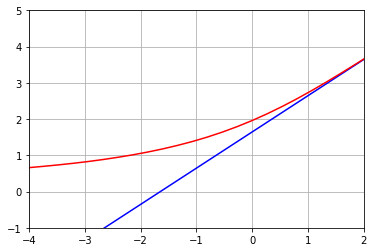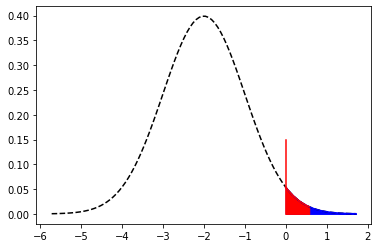Compute the bayesian upper limit for a gaussian near the physical boundary#
import numpy as np
from scipy.stats import norm
import matplotlib.pyplot as plt
%matplotlib inline
# Resolution
sigma_thetahat = 1.0
confidenceinterval = 0.95
def denominator(mu):
return 1-norm.cdf(0, mu, sigma_thetahat)
def numerator(mu, up):
return norm.cdf(up, mu, sigma_thetahat) - norm.cdf(0, mu, sigma_thetahat)
prob_left = 1 - confidenceinterval
theta_min = -4.0
theta_max = 4.0
theta_obsmin = -4.0
theta_obsmax = 4.0
thetas = [] # array to collect the scanned theta
lbounds = [] # array to collect the left bounds
bbounds = [] # bayesian bounds
nsteps = 30
step = 0.2
print ("theta_obs", "numerator", "denominator", "Ratio", "limit")
for i in range(nsteps+1):
theta = theta_min + i/nsteps*(theta_max-theta_min)
thetas.append(theta)
# upper limit
left_bound = norm.ppf(prob_left, loc=theta, scale=sigma_thetahat)
# print (theta, left_bound, right_bound)
lbounds.append(left_bound)
# bayesian upper limit: solve numerically to find the upper limit
up = 0.001
scanstep = 0.001
while (numerator(theta,up)/denominator(theta) < confidenceinterval) and (up < theta+5) :
# print (numerator(theta,up), denominator(theta), numerator(theta,up)/denominator(theta), up)
up+=scanstep
stringa = "{:.6f}".format(theta) + " {:.6f}".format(numerator(theta,up)) + " {:.6f}".format(denominator(theta)) + " {:.6f}".format(numerator(theta,up)/denominator(theta)) + " {:.6f}".format(up)
print (stringa)
bbounds.append(up)
plt.plot(lbounds,thetas, 'b-')
plt.plot(thetas,bbounds, 'r-')
plt.axis([-4,2,-1,5])
plt.xticks(np.arange(-4,3, 1.0))
plt.yticks(np.arange(-1,6, 1.0))
plt.grid()
plt.show()
theta_obs numerator denominator Ratio limit
-4.000000 0.000030 0.000032 0.950079 0.660000
-3.733333 0.000090 0.000094 0.950208 0.697000
-3.466667 0.000250 0.000263 0.950162 0.737000
-3.200000 0.000653 0.000687 0.950064 0.781000
-2.933333 0.001593 0.001677 0.950002 0.830000
-2.666667 0.003639 0.003830 0.950031 0.885000
-2.400000 0.007789 0.008198 0.950173 0.947000
-2.133333 0.015628 0.016449 0.950086 1.015000
-1.866667 0.029429 0.030974 0.950124 1.092000
-1.600000 0.052065 0.054799 0.950096 1.178000
-1.333333 0.086662 0.091211 0.950124 1.275000
-1.066667 0.135912 0.143061 0.950025 1.383000
-0.800000 0.201272 0.211855 0.950045 1.505000
-0.533333 0.282061 0.296901 0.950017 1.641000
-0.266667 0.375148 0.394863 0.950071 1.793000
0.000000 0.475002 0.500000 0.950004 1.960000
0.266667 0.574901 0.605137 0.950034 2.144000
0.533333 0.668002 0.703099 0.950083 2.344000
0.800000 0.748771 0.788145 0.950042 2.558000
1.066667 0.814162 0.856939 0.950082 2.786000
1.333333 0.863434 0.908789 0.950093 3.025000
1.600000 0.898037 0.945201 0.950102 3.273000
1.866667 0.920602 0.969026 0.950028 3.527000
2.133333 0.934454 0.983551 0.950081 3.787000
2.400000 0.942229 0.991802 0.950016 4.049000
2.666667 0.946425 0.996170 0.950064 4.314000
2.933333 0.948510 0.998323 0.950103 4.580000
3.200000 0.949431 0.999313 0.950084 4.846000
3.466667 0.949786 0.999737 0.950036 5.112000
3.733333 0.949989 0.999906 0.950079 5.379000
4.000000 0.949983 0.999968 0.950014 5.645000

# Example plot to show the ratio Num / Den
mu = -2
sigma = 1
x1 = np.linspace(norm.ppf(0.0001,mu, sigma), norm.ppf(0.9999,mu, sigma), 100)
x2 = np.linspace(norm.ppf(norm.cdf(0,mu, sigma),mu, sigma), norm.ppf(0.9999,mu, sigma),100)
x3 = np.linspace(norm.ppf(norm.cdf(0,mu, sigma),mu, sigma), norm.ppf(0.995,mu, sigma),100)
y1 = norm.pdf(x1,mu, sigma)
y2 = norm.pdf(x2,mu, sigma)
y3 = norm.pdf(x3,mu, sigma)
print(norm.cdf(0,mu, sigma))
plt.plot(x1, y1,'k--')
plt.plot(x2, y2,'b-')
plt.plot(x3, y3,'r-')
p1x = np.array([0,0])
p1y = np.array([0,0.15])
plt.plot(p1x, p1y, color='r' )
plt.fill_between(x2,y2,color='b')
plt.fill_between(x3,y3,color='r')
0.9772498680518208
<matplotlib.collections.PolyCollection at 0x7f0d090679d0>


